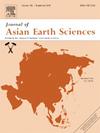藏南雅鲁藏布缝合带鲁曲蛇绿岩层序基性-中间岩的岩石成因及其对新特提斯演化的启示
IF 2.4
3区 地球科学
Q2 GEOSCIENCES, MULTIDISCIPLINARY
引用次数: 0
摘要
蛇绿岩提供了对消失海洋岩石圈的深入了解,并作为重建其进化史的关键档案。在藏南,暴露在雅鲁藏布缝合带内的蛇绿岩被解释为白垩纪新特提斯岩石圈的残余。然而,岩石圈残余物的成因和来源特征仍有争议。本文介绍了日喀则蛇绿岩鲁曲段地壳岩石(白云岩、玄武岩和辉长岩)的新地球化学资料。鲁曲北部剖面保存完整的地壳层序,以碎屑岩岩脉、杂岩杂岩和块状至枕状熔岩为主。值得注意的是,在白云岩中发现了少量的白辉长岩侵入。地球化学分析表明,白云岩和玄武岩的低稀土元素(LREE)模式呈扁平至中等贫化模式,与贫化地幔源的成因一致。白辉长岩的结晶年龄(132 ~ 125 Ma)与基性白云岩(~ 125 Ma)和其他YTSZ地壳序列(134 ~ 120 Ma)的结晶年龄重叠。矿物学上,含高镁斜辉石、高安斜长石、角闪洞,为含水母岩熔体。白长辉长岩显示出独特的同位素组成-非放射性的Sr-Hf与富集的Nd耦合。岩石学和地球化学证据表明,这些白辉长岩起源于下地壳辉长岩的部分熔融作用,其来源内的富集组分也有贡献。辉长岩固相可能是由于海水热液流体的渗透而降低的,这一过程在超低扩张背景下由滑脱断层促进。这些断裂使海水能够穿透,增强了流体-岩石相互作用和熔体杂交作用。日喀则蛇绿岩中的基性岩和浅辉长岩来源于一个超低扩张脊内不同的地幔域。本文章由计算机程序翻译,如有差异,请以英文原文为准。

Petrogenesis of mafic to intermediate rocks within the crustal sequence of the Luqu ophiolite in the Yarlung-Tsangpo suture Zone, southern Tibet and implications for the Neo-Tethys evolution
Ophiolites provide insights into the lithosphere of vanished oceans and serve as key archives for reconstructing their evolutionary histories. In southern Tibet, ophiolites exposed within the Yarlung-Tsangpo Suture Zone are interpreted as remnants of the Cretaceous Neo-Tethyan lithosphere. However, origin and source characteristics of these lithospheric remnants remain controversial. This study presents new geochemical data from crustal rocks (dolerites, basalts, and leugogabbros) within the Luqu section of the Xigaze ophiolites. The northern Luqu section preserves intact crustal sequence dominated by doleritic dykes, sill complexes, and massive to pillowed lavas. Notably, minor leucogabbro intrusions within the dolerites were identified. Geochemical analyses reveal that the dolerites and basalts exhibit flat to moderately depleted LREE patterns, consistent with derivation from a depleted mantle source. The leucogabbros yield crystallization ages (132 – 125 Ma) overlapping with those of the mafic dolerites (∼125 Ma) and other YTSZ crustal sequences (134 – 120 Ma). Mineralogically, they contain high-Mg# clinopyroxene, high-An plagioclase, and amphibole, suggesting hydrous parental melts. The leucogabbro display distinct isotopic compositions — unradiogenic Sr-Hf coupled with enriched Nd. Petrological and geochemical evidence indicates these leucogabbros originated via partial melting of lower crustal gabbros, with contributions from enriched components within their sources. Gabbro solidus was likely lowered by infiltration of seawater-derived hydrothermal fluids, a process facilitated by detachment faults in ultraslow-spreading settings. These faults enable seawater penetration, enhancing fluid-rock interaction and melt hybridization. Our findings suggest that mafic rocks and leucogabbros in the Xigaze ophiolites were sourced from distinct mantle domains within an ultraslow-spreading ridge.
求助全文
通过发布文献求助,成功后即可免费获取论文全文。
去求助
来源期刊

Journal of Asian Earth Sciences
地学-地球科学综合
CiteScore
5.90
自引率
10.00%
发文量
324
审稿时长
71 days
期刊介绍:
Journal of Asian Earth Sciences has an open access mirror journal Journal of Asian Earth Sciences: X, sharing the same aims and scope, editorial team, submission system and rigorous peer review.
The Journal of Asian Earth Sciences is an international interdisciplinary journal devoted to all aspects of research related to the solid Earth Sciences of Asia. The Journal publishes high quality, peer-reviewed scientific papers on the regional geology, tectonics, geochemistry and geophysics of Asia. It will be devoted primarily to research papers but short communications relating to new developments of broad interest, reviews and book reviews will also be included. Papers must have international appeal and should present work of more than local significance.
The scope includes deep processes of the Asian continent and its adjacent oceans; seismology and earthquakes; orogeny, magmatism, metamorphism and volcanism; growth, deformation and destruction of the Asian crust; crust-mantle interaction; evolution of life (early life, biostratigraphy, biogeography and mass-extinction); fluids, fluxes and reservoirs of mineral and energy resources; surface processes (weathering, erosion, transport and deposition of sediments) and resulting geomorphology; and the response of the Earth to global climate change as viewed within the Asian continent and surrounding oceans.
 求助内容:
求助内容: 应助结果提醒方式:
应助结果提醒方式:


